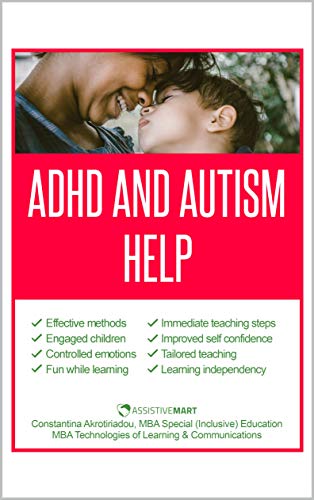Parenting a child with ADHD and autism can be both challenging and rewarding. It requires a unique set of skills and strategies to navigate the complexities of these conditions. So, how can you effectively parent a child with ADHD and autism? Let’s explore some practical tips and insights that can help you on this incredible journey.
When it comes to parenting a child with ADHD and autism, it’s essential to remember that every child is unique. There is no one-size-fits-all approach. However, there are some general strategies that can make a positive impact. Firstly, establishing a structured routine can provide a sense of stability and predictability for your child. This can help them feel more secure and reduce anxiety. Additionally, clear and consistent communication is key. Explaining expectations, setting boundaries, and using visual aids can enhance understanding and minimize misunderstandings. It’s also crucial to prioritize self-care as a parent. Taking care of your own physical and mental well-being will enable you to be more patient, understanding, and present for your child. By implementing these strategies and seeking support from professionals and other parents who have walked a similar path, you can create a nurturing and supportive environment for your child with ADHD and autism.
2. Establish routines: Create structured routines and schedules to help your child feel secure and reduce anxiety.
3. Set clear expectations: Clearly communicate rules and expectations, using visual aids if necessary.
4. Use positive reinforcement: Reward good behavior to encourage positive habits and discourage negative ones.
5. Provide a conducive environment: Create a calm and organized space at home to minimize distractions.
6. Seek professional help: Consult with doctors, therapists, and support groups for guidance and additional resources.
Remember, every child is unique, so be patient and flexible in finding what works best for your child.

Parenting a Child with ADHD and Autism: Tips and Strategies
Parenting a child with both ADHD and autism can present unique challenges. The combination of these two conditions requires a tailored approach to parenting that addresses the specific needs and behaviors associated with each. In this article, we will explore effective strategies and techniques that can help parents navigate the complexities of raising a child with ADHD and autism.
Understanding ADHD and Autism
ADHD (Attention Deficit Hyperactivity Disorder) and autism are neurodevelopmental disorders that commonly coexist. ADHD is characterized by symptoms such as hyperactivity, impulsivity, and inattention, while autism spectrum disorder (ASD) is characterized by difficulties in social interaction, communication, and repetitive behaviors. When a child has both conditions, it can result in a unique set of challenges for parents.
It is important for parents to have a thorough understanding of both ADHD and autism. Educating yourself about these disorders can help you better understand your child’s behaviors and needs. Consult with professionals, such as pediatricians, therapists, and special education teachers, who can provide valuable insights and guidance.
Creating a Structured Environment
Children with ADHD and autism thrive in structured environments. Establishing routines and schedules can help them feel more secure and provide a sense of predictability. Create a daily schedule that includes specific times for meals, homework, play, and bedtime. Display the schedule visually using charts or calendars to help your child understand and anticipate the day’s activities.
In addition to routines, it is important to create a physical environment that supports focus and minimizes distractions. Designate a quiet and organized space for homework or other activities that require concentration. Remove unnecessary clutter and noise from the environment to help your child stay focused.
Implementing Visual Supports
Visual supports can be incredibly beneficial when learning How To Parent A Child With Adhd And Autism These include visual schedules, social stories, and visual cues. Visual schedules provide a visual representation of the day’s activities, helping your child understand what to expect and transition between tasks. Social stories use pictures and simple language to explain social situations and appropriate behaviors. Visual cues, such as visual timers or checklists, can help your child stay on track and complete tasks independently.
Using visual supports not only enhances your child’s understanding, but it also reduces anxiety and promotes independence. Incorporate visuals into your daily routines and activities to support your child’s learning and communication.
Effective Communication and Social Skills
Children with ADHD and autism often struggle with communication and social skills. As a parent, it is essential to develop strategies to facilitate effective communication and help your child build social connections.
Encouraging Verbal and Nonverbal Communication
Encourage your child to express their thoughts and feelings through both verbal and nonverbal communication. Provide opportunities for them to practice communication skills at home, such as engaging in conversations, expressing emotions, and using gestures or sign language if needed. Model effective communication by using clear and concise language, active listening, and maintaining eye contact.
It is also important to be patient and understanding when your child struggles with communication. Encourage their efforts, provide gentle prompts, and use visual supports to aid comprehension. Celebrate their progress and provide positive reinforcement for their attempts at effective communication.
Promoting Social Interactions
Social interactions can be challenging for children with ADHD and autism. However, fostering social connections is crucial for their overall development and well-being. Find opportunities for your child to interact with peers in structured settings, such as playdates, clubs, or organized activities.
Teach your child social skills through role-playing, modeling, and explicit instruction. Focus on skills such as taking turns, sharing, listening, and empathy. Provide support during social interactions by offering guidance and feedback in real-time. Encourage your child to practice these skills in various social contexts to improve their social abilities over time.
Managing Challenging Behaviors
Children with ADHD and autism may exhibit challenging behaviors that can be overwhelming for parents. Understanding the underlying causes of these behaviors and implementing effective behavior management strategies can greatly improve the parent-child relationship and overall well-being.
Identifying Triggers and Antecedents
Challenging behaviors often have triggers or antecedents that precede them. It is crucial for parents to identify these triggers to prevent or minimize the occurrence of challenging behaviors. Observe your child’s behaviors and look for patterns or common factors that precede the behaviors. These triggers can be sensory stimuli, transitions, changes in routine, or specific situations. Once identified, take proactive steps to address or modify these triggers to prevent challenging behaviors from escalating.
Implementing Positive Reinforcement
Positive reinforcement is a powerful tool for shaping behavior in children with ADHD and autism. Rather than focusing solely on punishment or consequences for negative behaviors, emphasize positive reinforcement to encourage and reinforce desired behaviors. Use praise, rewards, and incentives to motivate your child and acknowledge their efforts and achievements. This approach promotes a positive parent-child relationship, increases motivation, and fosters a sense of accomplishment.
In conclusion, parenting a child with ADHD and autism requires a tailored approach that takes into account the unique needs and challenges associated with each condition. By creating a structured environment, implementing visual supports, fostering effective communication and social skills, and managing challenging behaviors, parents can provide the necessary support and guidance for their child’s development and well-being. Remember, each child is unique, and it may take time to find the strategies that work best for your child. Stay patient, seek professional guidance when needed, and celebrate the progress your child makes along the way.
Key Takeaways: How to Parent a Child with ADHD and Autism?
- Understand that every child is unique and has their own strengths and challenges.
- Establish a structured and predictable routine to help your child feel secure.
- Communicate openly and honestly with your child about their conditions in an age-appropriate manner.
- Seek support from professionals, such as therapists and doctors, to develop a personalized treatment plan.
- Practice patience and empathy, remembering that your child may have difficulty with impulse control and social interactions.
Frequently Asked Questions
Question 1: What are some effective strategies for parenting a child with ADHD and autism?
When learning How To Parent A Child With Adhd And Autism, it is important to implement strategies that address their unique needs and challenges. Here are some effective strategies:
1. Establish routines and structure: Children with ADHD and autism thrive on routine and structure. Create a consistent daily schedule that includes specific times for meals, playtime, homework, and bedtime.
2. Use visual aids and cues: Visual aids such as charts, calendars, and timers can help children with ADHD and autism understand and follow instructions. Use visual cues to remind them of tasks or responsibilities.
3. Break tasks into manageable steps: Break down tasks into smaller, more manageable steps to help your child stay focused and organized. Provide clear instructions and offer support and encouragement along the way.
4. Provide positive reinforcement: Praise and reward your child’s efforts and achievements. Positive reinforcement can motivate and encourage your child to continue practicing positive behaviors.
Question 2: How can I support my child’s learning and development?
Supporting your child’s learning and development is crucial for their overall growth. Here are some ways to support your child:
1. Collaborate with teachers and therapists: Maintain open communication with your child’s teachers and therapists to ensure consistency in their learning and development goals. Share strategies that work well at home and ask for suggestions to reinforce learning in different settings.
2. Provide a structured learning environment: Create a calm and organized learning environment at home. Minimize distractions and provide a designated study area that is free of clutter. Break learning tasks into smaller, achievable goals to prevent overwhelm.
3. Encourage self-expression and creativity: Foster your child’s self-expression and creativity through activities such as art, music, and imaginative play. These outlets can help them explore their interests and develop their talents.
4. Celebrate progress and milestones: Celebrate your child’s accomplishments, no matter how small. Recognize their efforts and highlight the progress they have made. This positive reinforcement can boost their self-esteem and motivation to continue learning and growing.
Question 3: How can I manage challenging behaviors in my child with ADHD and autism?
Managing challenging behaviors in a child with ADHD and autism requires patience, understanding, and consistent strategies. Here are some tips:
1. Establish clear expectations and rules: Clearly communicate your expectations and establish rules that are consistent and easy for your child to understand. Reinforce these rules with visual cues and reminders.
2. Use positive discipline techniques: Rather than focusing on punishment, use positive discipline techniques such as redirection, praise, and rewards. Encourage positive behaviors and provide alternatives to challenging behaviors.
3. Create a calm and structured environment: A calm and structured environment can help prevent and manage challenging behaviors. Create a designated space for relaxation and provide sensory tools or activities that can help your child self-regulate.
4. Seek support from professionals: If you are struggling to manage challenging behaviors, seek support from professionals such as therapists or behavior specialists. They can provide guidance and develop individualized strategies for your child.
Question 4: How can I promote social skills development in my child with ADHD and autism?
Promoting social skills development in a child with ADHD and autism is important for their social interactions and overall well-being. Here are some ways to promote social skills:
1. Encourage social interactions: Create opportunities for your child to interact with peers, siblings, or other family members. Encourage turn-taking, sharing, and cooperative play.
2. Teach social cues and communication skills: Help your child understand social cues and nonverbal communication by using visual aids or social stories. Practice conversational skills and encourage active listening.
3. Support friendships and social connections: Foster friendships by arranging playdates or joining social groups specifically designed for children with ADHD and autism. Encourage your child to build relationships and maintain social connections.
4. Role-play and practice social scenarios: Role-play different social scenarios with your child to help them navigate social situations. Provide feedback and guidance on appropriate social behaviors and problem-solving skills.
Question 5: How can I take care of myself while parenting a child with ADHD and autism?
Parenting a child with ADHD and autism can be challenging, and it is important to prioritize self-care. Here are some self-care tips:
1. Seek support from others: Reach out to family, friends, or support groups who can offer understanding and support. Sharing your experiences and emotions with others who are going through similar situations can provide comfort and guidance.
2. Take breaks and practice self-care activities: Set aside time for yourself to recharge. Engage in activities that bring you joy and relaxation, such as exercising, reading, or pursuing hobbies.
3. Prioritize your physical and mental health: Take care of your physical health by eating nutritious meals, getting enough sleep, and exercising regularly. Prioritize your mental health by practicing stress management techniques, such as meditation or journaling.
4. Celebrate small victories: Recognize and celebrate the small victories and achievements, both in your child’s progress and in your own parenting journey. Remember that self-care is essential for your well-being and your ability to support your child effectively.

Final Thoughts: Parenting a Child with ADHD and Autism
Navigating the world of parenting can be challenging, and when you add the complexities How To Parent A Child With Adhd And Autism into the mix, it can feel like an uphill battle. But fear not, dear parents, for you are not alone in this journey. While there is no one-size-fits-all approach to parenting a child with ADHD and autism, there are strategies and techniques that can make your life a little easier and help your child thrive.
First and foremost, remember that patience is key. It’s important to understand that your child’s behaviors are not intentional but a result of their neurodiverse condition. Celebrate their strengths and support them through their challenges. Seek out a strong support network of professionals, other parents in similar situations, and online communities where you can share experiences and learn from others.
In addition, creating a structured and consistent routine can provide a sense of stability for your child. Establish clear rules and expectations, and break tasks down into manageable steps. Use visual aids and schedules to help them understand and follow routines. Encourage positive behavior through rewards and praise, and remember to practice self-care to keep yourself mentally and physically healthy.
Remember, there is no perfect way to parent, and it’s okay to make mistakes along the way. Trust your instincts and believe in your ability to provide the best possible support for your child. With love, patience, and perseverance, you can create a nurturing environment where your child can thrive and reach their full potential.







